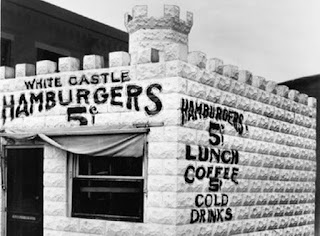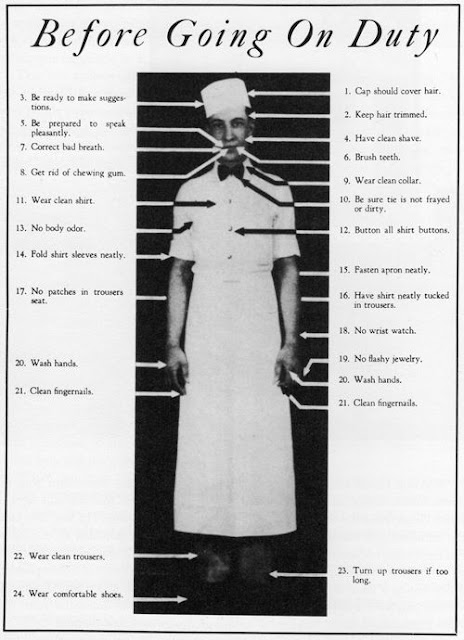One of my guilty pleasures when flying into Detroit is stopping at the White Castle on Telegraph Road and Northline. My favorite item is the #2 combo--two double-cheese burgers and fries with a medium soft drink. The family-owned chain services the Midwest and Mid-Atlantic states, so most of the country is unaware of this delectable taste treat.
Their signature product consists of a thin square of 100% ground beef with five steam holes punched into it. The patty is cooked on a bed of diced onions and topped with a steamed hamburger bun, dressed with dill pickles, mustard and ketchup, and served up in a cardboard sleeve. One food critic called it "French onion soup on a bun." To be honest, either you love them or you hate them.
Walter A. Anderson began his restaurant career working at food stands in Wichita, Kansas. In 1916, he bought an obsolete streetcar and converted it into a diner. He had opened two more diners by the time he met businessman Edgar Wolds "Billy" Ingram and co-founded the first White Castle restaurant on an original investment of $700 in 1921.
Since the publication of The Jungle by Upton Sinclair in 1906 exposing the unsanitary practices of the meat packing industry in Chicago, Americans were reluctant to eat ground beef. Aware of this, the White Castle founders sought to change the public's perception by stressing cleanliness in their restaurants and high quality ingredients.
 |
| White Castle slider |
 |
| White Castle #1 |
Their earliest buildings had white enameled brick exteriors and enameled steel counters. By the 1930s, the chain's restaurants were built with prefabricated white-porcelain enameled steel exteriors and outfitted with stainless steel counters. Buildings were designed so customers could see their food being prepared by employees who had to conform to a strict dress code. White Castle produced the first disposable paper hats, napkins, and cardboard sleeves to package their product.
Short-order cook Walter Anderson is credited with the invention of the hamburger bun and the assembly-line kitchen which replaced experienced cooks with employees who could operate the griddle with minimal training. Chain-wide standardization assured the same product and service at all their locations. Often imitated but never duplicated, numerous earlier competitors were unable to match White Castle's success.
The fast-food industry we take for granted today was unknown in America before the White Castle chain. Anderson and Ingram gave rise to the fast-food phenomenon. There was no infrastructure to support their business expansion, so Anderson and Ingram established centralized bakeries, meat suppliers, branded paper manufacturing, and warehouses to supply their system's needs.
In 1933, Anderson sold his half of the business to Billy Ingram. The following year, the company moved its corporate offices to Columbus, Ohio, the center of their distribution area. Ingram's business savvy is credited for the popularity of the hamburger in America.
Since the beginning, White Castle has been privately owned, and none of its restaurants are franchised. Founder Billy Ingram retired in 1958 as CEO, followed by his son E.W. Ingram Jr, and then his grandson E.W. Ingram III. In December 2015, Ingram III stepped down and his daughter Lisa Ingram became the fourth CEO of the company.
The Ingram family's refusal to franchise or take on debt throughout the company's existence has kept the chain relatively small with only about 420 outlets--all in the United States. By comparison, McDonald's has 36,000 outlets worldwide with 14,000 of those in the United States. In recent years, White Castle has been selling sliders at supermarkets nationwide.
On January 27, 2015, White Castle opened its first outlet in the western United States at the Casino Royale Hotel on the Las Vegas Strip--the chain's first expansion into a different state in fifty-six years. On its first day of business, the restaurant had to close for two hours to restock their depleted supplies. In its first twelve hours of operation, the store sold 4,000 sliders per hour. It appears that I'm not the only one who enjoys this guilty pleasure.
Delray, Detroit and O-So Pop: https://fornology.blogspot.com/2014/08/detroits-ghost-town-delray-and-o-so.html
Short-order cook Walter Anderson is credited with the invention of the hamburger bun and the assembly-line kitchen which replaced experienced cooks with employees who could operate the griddle with minimal training. Chain-wide standardization assured the same product and service at all their locations. Often imitated but never duplicated, numerous earlier competitors were unable to match White Castle's success.
The fast-food industry we take for granted today was unknown in America before the White Castle chain. Anderson and Ingram gave rise to the fast-food phenomenon. There was no infrastructure to support their business expansion, so Anderson and Ingram established centralized bakeries, meat suppliers, branded paper manufacturing, and warehouses to supply their system's needs.
In 1933, Anderson sold his half of the business to Billy Ingram. The following year, the company moved its corporate offices to Columbus, Ohio, the center of their distribution area. Ingram's business savvy is credited for the popularity of the hamburger in America.
Since the beginning, White Castle has been privately owned, and none of its restaurants are franchised. Founder Billy Ingram retired in 1958 as CEO, followed by his son E.W. Ingram Jr, and then his grandson E.W. Ingram III. In December 2015, Ingram III stepped down and his daughter Lisa Ingram became the fourth CEO of the company.
The Ingram family's refusal to franchise or take on debt throughout the company's existence has kept the chain relatively small with only about 420 outlets--all in the United States. By comparison, McDonald's has 36,000 outlets worldwide with 14,000 of those in the United States. In recent years, White Castle has been selling sliders at supermarkets nationwide.
Delray, Detroit and O-So Pop: https://fornology.blogspot.com/2014/08/detroits-ghost-town-delray-and-o-so.html







